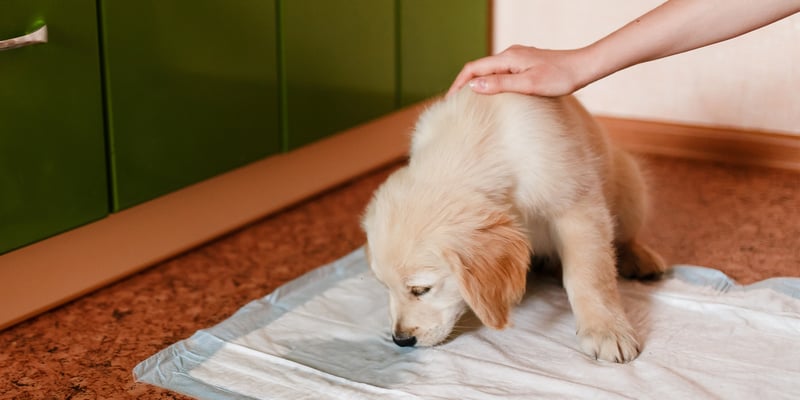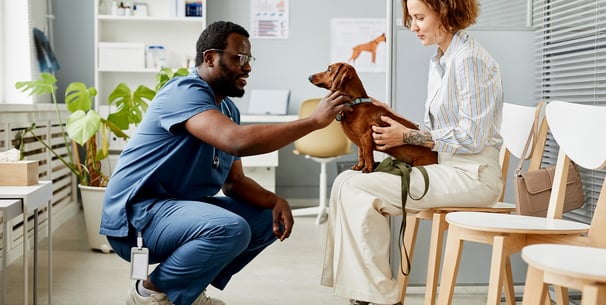Understanding Dog Incontinence: Causes & Care
Index:



Introduction
Dog incontinence is a common condition in which a dog loses control of their bladder, resulting in involuntary urine leakage. It can be caused by various factors, including age-related changes, hormonal imbalances, neurological conditions, infections and anatomical anomalies.
Identifying the underlying causes of any concerning health issue, including dog incontinence is crucial in order to provide appropriate care and ensure the dog's comfort and well-being. Addressing dog incontinence is important as it can cause discomfort and distress to the dog and hygiene issues for the owner.
Key takeaways:
Dog incontinence is a condition where a dog involuntarily loses control of their bladder.
Causes of dog incontinence include age-related changes, hormonal imbalances, neurological conditions, infections, and anatomical anomalies.
It is important to identify the underlying causes of dog incontinence in order to provide appropriate care and ensure the dog's comfort and well-being.
Addressing dog incontinence is crucial to improve the dog's quality of life and prevent complications such as skin infections and urinary tract problems.
Treatment options for dog incontinence may include medications, hormone therapy, surgical interventions and lifestyle modifications.



What is dog incontinence and why is it a concern?
Dog incontinence refers to the loss of bladder control, leading to involuntary urine leakage. It is a concern because it can cause discomfort and distress to the dog, as well as hygiene issues for the owner.
Addressing dog incontinence is crucial to improve the dog's quality of life and prevent complications such as skin infections and urinary tract problems.
Managing dog incontinence involves identifying the underlying causes, implementing appropriate treatment options, and creating a supportive home environment.
For insights on increased water consumption in older dogs, read our expert guide to older dogs and increased thirst.
Learn about the benefits of pet insurance in managing these issues by reading our blog post comparing the best pet insurance providers.
Dog incontinence can be a challenging condition to deal with, but with the right care and management, dogs can still live happy and fulfilling lives.
To effectively address dog incontinence, it is important to understand the causes and seek appropriate veterinary care. Identifying the underlying factors contributing to incontinence allows for targeted treatment and management strategies.
Some of the common causes of dog incontinence include age-related changes, hormonal imbalances, neurological conditions, infections and anatomical anomalies.
Learn more about other important health-related issues in our detailed guide on dogs and paracetamol, which touches on medication safety and its effects.
Age-related incontinence is often seen in older dogs as the muscles controlling the bladder weaken over time. Hormonal imbalances, such as low oestrogen levels in spayed females, can also contribute to incontinence.
Neurological factors and spinal conditions can affect the nerves that control bladder function leading to incontinence. Infections and anatomical anomalies, such as urinary tract infections and abnormalities in the urinary tract, can also be underlying causes of incontinence.
Recognising the signs of dog incontinence is crucial in seeking diagnosis and appropriate treatment. Common symptoms include wet patches on bedding or floor, frequent urination and excessive drinking.
Thorough veterinary assessments, including physical examinations and medical history reviews, are important for accurate diagnosis. Investigative procedures such as blood tests, imaging and urine cultures may be conducted to identify the underlying causes of incontinence.
Providing essential care and treatment for incontinent dogs is crucial to managing the condition and improving their quality of life. Treatment options may include medications to improve bladder control, hormone therapy, surgical interventions and lifestyle modifications.
For insights into safely medicating pets and ensuring their comfort, consider reading our other articles covering frequently asked questions such as: is Piriton safe for dogs?
In addition to medical interventions, using dog incontinence products such as incontinence pads, washable absorbent sleep mats, and washable dog nappies can help manage the condition and maintain hygiene.
Implementing effective management strategies is key to dealing with dog incontinence. This includes a combination of medical interventions, lifestyle changes, and supportive home environments.
By addressing dog incontinence and providing appropriate care, you can ensure your beloved pets are comfortable and enjoy a good quality of life, despite their incontinence.



Identifying the causes of dog incontinence
Dog incontinence can have various causes, including age-related changes, hormonal imbalances, neurological factors and infections.
Understanding these underlying factors is essential in addressing and managing dog incontinence effectively.
Age-related incontinence in dogs
As dogs age, their bladder muscles may weaken, leading to involuntary urine leakage. Age-related incontinence is commonly seen in older dogs and can be a significant contributing factor to their loss of bladder control.
Hormonal imbalances and their role
Hormonal imbalances, such as low oestrogen levels in spayed females, can also play a role in dog incontinence.
Oestrogen helps maintain the strength and tone of the muscles that control urination. When oestrogen levels are low, these muscles may weaken, leading to urinary incontinence in female dogs.
Neurological factors and spinal conditions
Neurological factors and spinal conditions can impact the nerves that control bladder function in dogs.
Nerve damage or compression in the spinal cord can interfere with the proper signalling between the brain and the bladder, resulting in incontinence.
Infections and anatomical anomalies
Infections, such as urinary tract infections, can cause inflammation and irritation in the urinary tract, leading to incontinence in dogs.
Anatomical anomalies, like abnormalities in the urinary tract, can also disrupt normal bladder function and contribute to urinary incontinence.



Understanding dog incontinence: evaluating symptoms and seeking diagnosis
Recognising the signs: from wet patches to frequent urination
Recognising the signs of dog incontinence is crucial in seeking diagnosis and appropriate treatment. Some common symptoms of dog incontinence include:
Wet patches on bedding or floor
Frequent urination
Excessive drinking
The importance of thorough veterinary assessments
To accurately diagnose dog incontinence, thorough veterinary assessments are essential. Veterinarians will typically perform the following:
Physical examinations: during a physical examination, the veterinarian will check for any physical abnormalities, bladder distension, and signs of infection or inflammation.
Medical history review: understanding a dog's medical history, including any previous illnesses or surgeries, can provide valuable insights into the potential causes of incontinence.
Investigative procedures: blood tests, imaging and urine cultures
To identify the underlying causes of dog incontinence, veterinarians may recommend the following diagnostic procedures:
By conducting these investigative procedures, veterinarians can gather valuable information to determine the most appropriate treatment plan for dog incontinence.



Essential care and treatment options for incontinent dogs
Providing essential care and treatment for incontinent dogs is crucial to managing the condition and improving their quality of life. Treatment options can vary depending on the underlying causes and severity of incontinence. Here are some key approaches:
1. Medications: Certain medications can help improve bladder control in dogs with incontinence. These medications work by strengthening the muscles that control the bladder or by reducing inflammation in the urinary tract. It is important to consult with a veterinarian to determine the most appropriate medication and dosage for the dog.
2. Hormone therapy: In some cases, hormonal imbalances may contribute to dog incontinence. Hormone therapy, such as oestrogen supplementation, can be used to manage incontinence caused by low oestrogen levels. This treatment option is typically recommended for spayed female dogs.
3. Surgical interventions: In certain situations, surgical interventions may be necessary to address the underlying causes of incontinence. For example, surgery may be performed to correct anatomical anomalies or to repair damaged bladder muscles. The decision to undergo surgery should be made in consultation with a veterinarian.
4. Lifestyle modifications: Making specific changes to the dog's daily routine and environment can help manage incontinence. This may include establishing regular bathroom breaks, ensuring easy access to outdoor areas, and maintaining a consistent feeding and drinking schedule. Providing a calm and stress-free environment can also contribute to bladder control.
Discover answers to questions and practical advice in our article about why dogs roll in poop, which can also help in managing cleanliness and hygiene for incontinent pets.



Dog incontinence products
Washable dog nappies
PETTING IS CARING Dog Diapers offer a washable and reusable solution for pet owners dealing with dog incontinence. These diapers are designed for both male and female dogs, providing a comfortable and secure fit with adjustable Velcro closures. They're also ideal for managing inappropriate urination due to medical conditions like bladder infections.
The nappies are made from durable, machine-washable materials, making them an eco-friendly option for managing leak urine. With a high absorbency level, they prevent leaks, keeping your home clean while offering medical treatment support for your furry friend.
Dog incontinence pads
Baodan Reusable Dog Training Pads are a sustainable choice for pet parents navigating the challenges of urine infection.
These dog incontinence pads are not only super absorbent but also boast leak-proof materials, making them ideal for pets suffering from kidney disease.
They're perfect for pet owners seeking an effective solution for managing amounts of urine. The pads' quick-dry feature and durability offer a comfortable experience for pets, ensuring homes stay clean and hygienic.
Dog incontinence pants
Vetsend's Dog Incontinence Pants provide a tailored solution for managing anatomic abnormalities, especially for pets suffering from dog urinary incontinence.
These incontinence pants for dogs are designed to offer comfort and leak protection, allowing pet parents to effectively care for their pets.
A valuable addition to the range of products for dog incontinence, these pants help maintain hygiene and comfort for both pets and their owners, ensuring peace of mind in managing this medical condition.
In addition to these treatment options, there are also other various dog incontinence products available to assist in managing the condition - effectively preventing urine leakage whilst protecting furniture, bedding and flooring from stains and odours.



Conclusion
For pet owners, any health mysteries can leave us a little worried. Especially, when we don't know what is wrong.
When it comes to dog incontinence, whether it's medication to improve bladder control or surgical interventions to address anatomical anomalies, we all just want the best options to alleviate symptoms and improve our dog's comfort.
Creating a supportive home environment is equally vital in managing dog incontinence. And don't forget - ensure easy access to outdoor areas so your dog can relieve themselves regularly.
If you're a Waggel member, you can get exclusive and free access to 24/7 online pet care with Joii to help with any further questions you may have.
We also have a range of information other health issues, covering everything from head to paw. At Waggel, we love to help your dog live their most joyful life. For more on this, read our guide on how to make your dog happy.
FAQs
What is dog incontinence?
Dog incontinence refers to the loss of bladder control, leading to involuntary urine leakage.
Why is dog incontinence a concern?
Dog incontinence can cause discomfort and distress for the dog, as well as hygiene issues for the owner. It is important to address it to improve the dog's quality of life and prevent complications.
What are the causes of dog incontinence?
Dog incontinence can be caused by age-related changes, hormonal imbalances, neurological conditions, infections and anatomical anomalies.
What are the signs of dog incontinence?
Signs of dog incontinence can include wet patches on bedding or floor, frequent urination and excessive drinking.
How is dog incontinence diagnosed?
Dog incontinence is diagnosed through thorough veterinary assessments, which may include physical examinations, medical history review, blood tests, imaging and urine culture samples.
How is dog incontinence treated?
Treatment options for dog incontinence vary and can include medications to improve bladder control, hormone therapy, surgical interventions, lifestyle modifications and the use of incontinence products.
What can I do to manage my dog's incontinence?
Effective management of dog incontinence involves implementing medical interventions, creating a supportive home environment, and using incontinence products to ensure your dog's comfort and well-being.
Waggel Pet Insurance
Need more help? You're in luck if you're a Waggel Pet Insurance member. Along with our excellent coverage, we offer access to a 24/7 online vet to answer all your sticky questions, especially if you need grooming assistance.
Not a member? Why not get a quote now and cover your furry friend for a range of illnesses, all while enjoying our amazing perks and rewards.
Want more like this?
Get updates from us with helpful info, advice, answers to frequently asked questions and much more.
Index:
Related posts:
Get your quote
Along with our excellent coverage, we offer access to a 24/7 online vet to answer all your sticky questions.





